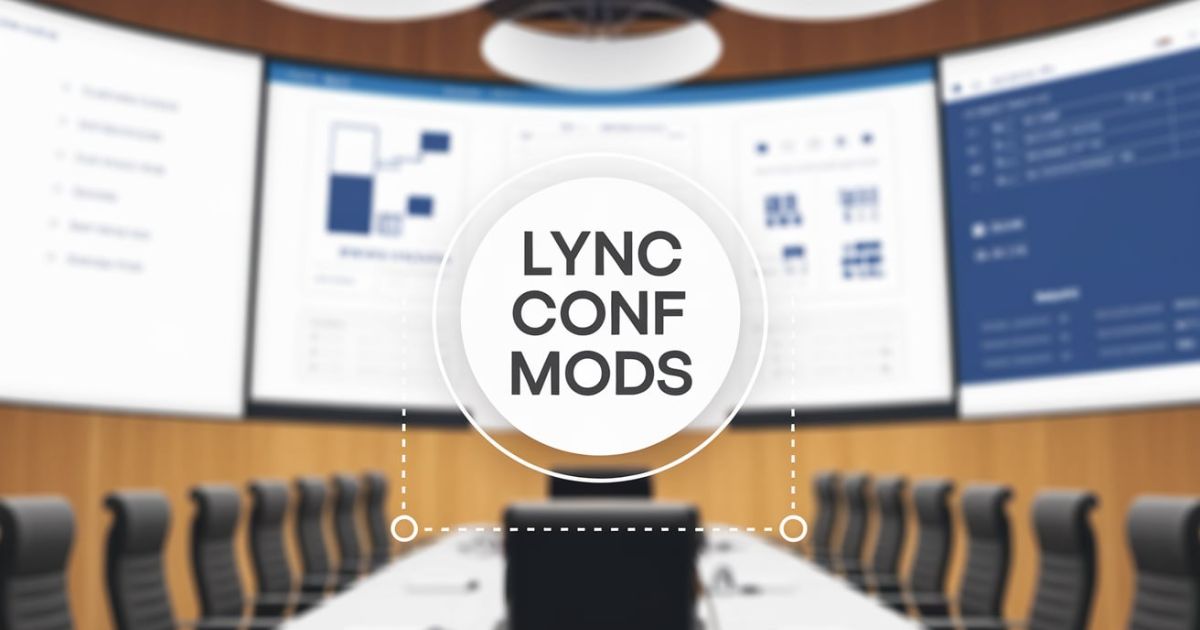Understanding Lync Conferencing Capabilities
Microsoft Lync, which has evolved into Skype for Business, stands as a cornerstone of unified communication in the modern enterprise landscape.
As organizations continue to embrace digital transformation, this powerful platform combines essential communication tools into a single, cohesive solution.
The system integrates instant messaging, voice, video, and conferencing capabilities, creating a comprehensive environment for business collaboration.
At its core, Lync provides fundamental features that drive enterprise collaboration. The platform’s instant messaging and presence capabilities enable real-time communication while keeping users informed about their colleagues’ availability.
The sophisticated audio and video conferencing system supports both intimate team discussions and large-scale corporate meetings. Additionally, the platform’s file and screen sharing capabilities facilitate seamless information exchange during virtual meetings.
Key Areas for Lync Conference Modifications
Customizing Conference Policies
Conference policies serve as the backbone of Lync Conf Mods, determining how meetings function and what participants can do within them.
These policies govern everything from basic access controls to advanced interaction permissions, allowing organizations to create a conferencing environment that aligns with their specific requirements.
Administrators can configure joining permissions to manage access for both internal and external participants, implementing strict controls over anonymous access when needed.
User roles can be defined with precision, establishing clear hierarchies between attendees, presenters, and organizers.
Video control settings allow for granular management of bandwidth usage, while meeting expiration policies help maintain system efficiency by automatically clearing outdated meeting data.
The Lync Server Management Shell provides powerful tools for implementing these modifications through PowerShell commands.
For instance, administrators can use commands to adjust video settings, manage user permissions, or implement specific conference policies across different departments.
Read This Post: Hearthstats Net News – Key Updates For Players!
Security and Compliance Enhancements
In today’s digital landscape, security stands as a paramount concern for organizations implementing virtual conferencing solutions.
Data encryption serves as the foundation of secure communications, ensuring that all conference content remains protected.
The meeting lobby feature provides an additional layer of security by creating a virtual waiting room where organizers can verify participants before granting access.
Recording permissions play a crucial role in maintaining data privacy and compliance, allowing organizations to control who can capture meeting content and how that information is stored.
Conference locking provides real-time security control, enabling organizers to prevent unauthorized access once a meeting has begun.
Audio and Video Configuration
The quality of audio and video communications significantly impacts the effectiveness of virtual meetings. Organizations must carefully balance performance requirements with available bandwidth resources.
Bitrate adjustments provide precise control over video quality, while HD video control allows administrators to manage high-definition content access based on network capabilities.
Muted entry settings help maintain meeting professionalism by automatically silencing participants upon joining, reducing disruptions in large conferences.
Organizations can implement these controls through the Lync Server Control Panel or PowerShell commands, ensuring optimal performance across their network.
Dial-In Conferencing and Regional Settings
For global organizations, effective dial-in conferencing capabilities are essential. Administrators can configure regional settings to accommodate users across different time zones and locations, ensuring seamless access regardless of geographical location.
This includes setting up local dial-in numbers and customizing language settings for voice prompts and meeting notifications.
The system supports multiple authentication methods for dial-in users, maintaining security while providing convenient access options.
Regional configurations can be managed through PowerShell commands or the Lync Server Control Panel, allowing for efficient deployment across global networks.
Leveraging Advanced PowerShell Commands
The power of PowerShell in managing Microsoft Lync extends far beyond basic configuration tasks. Administrators can create sophisticated automation scripts for managing conference settings across large user groups.
For example, the command {Get-CsUser -Filter {Department -eq “Sales”} | Grant-CsConferencingPolicy -PolicyName “SalesConferencingPolicy”} enables efficient bulk policy assignment for entire departments.
Scheduled report generation capabilities allow organizations to maintain comprehensive oversight of their conferencing environment.
These reports can track usage patterns, monitor system performance, and identify potential issues before they impact users. Through PowerShell, administrators can create customized reporting solutions that address specific organizational needs.
Enhancing the User Experience with Lync Conf Mods
The success of any conferencing solution ultimately depends on user adoption and satisfaction. One-click meeting access streamlines the connection process, reducing friction and improving participation rates.
Integration with calendar systems and email clients creates a seamless experience for users scheduling and joining meetings.
Customizable notifications help organizations maintain the right balance between keeping users informed and avoiding notification fatigue.
These can be tailored based on user roles, departments, or individual preferences. Personalized roles streamline meeting management by automatically assigning appropriate permissions based on organizational hierarchy or meeting type.
Testing and Monitoring Conference Modifications
Implementing changes to conferencing systems requires careful testing and ongoing monitoring to ensure optimal performance.
The Lync Server Control Panel provides comprehensive tools for tracking system health and user experience metrics.
Regular performance monitoring helps identify potential bottlenecks and opportunities for optimization.
Administrators should establish a systematic approach to testing new configurations before full deployment.
This includes verifying security settings, checking audio and video quality, and confirming that all modified features function as intended.
User feedback plays a crucial role in this process, helping identify any unexpected issues or areas for improvement.
Best Practices for Implementation
When implementing Lync Conf Mods, organizations should follow a structured approach to ensure success.
This begins with a thorough assessment of current needs and capabilities, followed by careful planning of desired modifications.
Documentation of all changes helps maintain system consistency and facilitates troubleshooting when needed.
The implementation process should include regular checkpoints to verify that modifications align with organizational goals and compliance requirements.
This includes monitoring network performance, security metrics, and user satisfaction levels. Regular reviews of system logs and performance data help identify opportunities for further optimization.
Future Considerations and Scalability
As organizations grow and evolve, their conferencing needs often change. Planning for scalability ensures that Microsoft Lync can continue to meet these changing requirements.
This includes considering future bandwidth needs, potential increases in user numbers, and emerging security challenges.
Cloud integration capabilities may provide additional flexibility for organizations looking to expand their conferencing capabilities.
Understanding how Lync Conf Mods can be adapted to support hybrid environments helps ensure long-term viability of the system.
Conclusion
The effective implementation of Lync Conf Mods represents a significant opportunity for organizations to enhance their communication capabilities.
Through careful configuration of conference policies, security settings, and user experience features, administrators can create a robust and efficient conferencing environment that meets specific organizational needs.
Success in this endeavor requires a balanced approach that considers technical requirements, user needs, and security considerations.
Regular monitoring and adjustment of configurations ensures that the system continues to provide optimal performance as organizational needs evolve.
Whether supporting small team meetings or large-scale corporate events, properly configured Microsoft Lync provides a powerful platform for modern business communication.
The future of enterprise collaboration continues to evolve, and Lync remains at the forefront of this evolution. By maintaining awareness of new capabilities and regularly updating configurations to take advantage of them, organizations can ensure their conferencing systems continue to provide maximum value.
Through careful attention to security, performance, and user experience, administrators can create a conferencing environment that supports their organization’s communication needs both today and in the future.
This comprehensive approach to Lync configuration and management helps organizations maximize the value of their unified communications investment while maintaining the security and reliability their users expect.
As virtual meetings continue to play an increasingly important role in business operations, the ability to effectively customize and manage conferencing systems becomes ever more crucial to organizational success.
Vividcrest admin brings expert insights in Tech and Gaming, offering up-to-date content, in-depth analysis, and trends to keep you ahead in the digital world.








